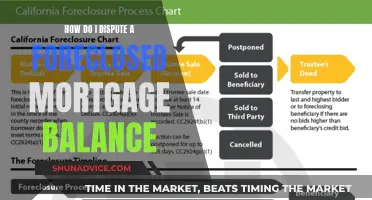
Discharging a mortgage involves removing the mortgage security from the title of your property once you have repaid your home loan in full. The process differs depending on the location and the lender, and you may need to work with a lawyer or notary to fill out the necessary paperwork. There are typically fees involved in discharging a mortgage, including lender's discharge fees, professional fees, and potential penalty fees. This paragraph provides an overview of the topic, and further details on each aspect will be discussed in the following sections.
| Characteristics | Values |
|---|---|
| When to discharge a mortgage | After paying off your mortgage in full, when changing lenders, or when selling your property |
| Who can discharge a mortgage | You, your lawyer, or your notary |
| Requirements | All required documents must be provided to the land registry office |
| Documents | Mortgage discharge authority form, a letter from the lender stating that you have paid off the mortgage in full |
| Fees | Lender's discharge fees ($0-$400), professional fees ($400-$2500), penalty fee (if you break your mortgage contract) |
What You'll Learn

When to discharge your mortgage
There are several instances when you might need to discharge your mortgage. The first and most common is when you have paid off your mortgage in full. However, you must ensure that you don't owe money on any other loans secured against your home, such as a home equity line of credit (HELOC). If you do, you must pay off and close these accounts before applying for a mortgage discharge.
You will also need to discharge your mortgage when you change lenders. When you do this, the information on your property's title must be updated. You must discharge the mortgage from the previous lender and add the new lender to the property's title.
You must also discharge your mortgage when you sell your property. You, your lawyer, or your notary must complete all the steps in the discharge process of your provincial or territorial land registry office.
Finally, you may also want to discharge your mortgage if you refinance or release a family guarantee.
Applying for Mortgage Relief: A Step-by-Step Guide
You may want to see also

How to discharge your mortgage
Discharging a mortgage involves removing the mortgage that secures your home loan from the title of your property. This happens once you have fully repaid your loan. The specific process for discharging your mortgage will depend on the rules and regulations of the province or territory in which you live.
In some cases, you may be able to fill out the mortgage discharge document yourself and have it notarised. In other cases, you may need a professional, such as a lawyer, notary, or commissioner of oaths, to fill out the form for you. You can obtain the form from your local Registry of Deeds office or website, or from a real estate attorney. Once you have the form, you can schedule a meeting with your mortgage lender and a lawyer, notary, or commissioner of oaths.
After the form is filled out, you will pay any applicable fees. You will then receive a letter stating that your mortgage has been officially discharged. Make copies of this letter and take one to the Registry of Deeds office, where you may be required to pay a filing fee. This final step ensures that the discharge is officially documented.
It's important to note that you must also ensure that you don't have any amounts owing on any related products. For example, if you have a home equity line of credit (HELOC) with your mortgage, you need to pay it off and close it before getting a mortgage discharge. Additionally, when you change lenders, you must discharge the mortgage from the previous lender so that the new information is on the property's title.
Wells Fargo Mortgage: Contacting the Right Department
You may want to see also

Mortgage discharge authority form
A mortgage discharge authority form is used when you sell, refinance, pay off your loan, or release a family guarantee. This form is used to give instructions to your lender about your loan. The form must be completed and signed before being given to your conveyancer, solicitor, or mortgage broker, who will handle the rest of the process.
Mortgage discharge forms are available for all major lenders, including ANZ, BankWest, CBA, NAB, St George, and Westpac. Some lenders, such as Mortgage Ezy, Rams Home Loans, RESI Home Loans, and Suncorp Bank, require that you call them to request a discharge form. Suncorp Bank, for instance, provides each client with a unique discharge form.
If you are selling your property, it is recommended to submit the signed discharge form to your conveyancer or solicitor at least four weeks before the settlement. Similarly, if you are refinancing your mortgage through a broker, you should give them the signed form, and they will handle the rest. However, if you are refinancing without a broker, it is important to commence the discharge process simultaneously with your application for a new mortgage to avoid delays in settlement.
It is worth noting that lenders may take their time in processing your discharge request, as there is little incentive for them to expedite the process. On average, lenders can take up to four weeks to complete the discharge, but it is common for it to take around two weeks. To prevent delays in the settlement of your new home loan, it is advisable to submit your discharge request alongside your new loan application.
Carrying a Mortgage for Another: What You Need to Know
You may want to see also

Fees and charges
Discharge fees are typically charged by lenders when you exit your home loan. These fees are often referred to as exit fees, termination fees, or settlement fees. The amount of the discharge fee can vary greatly between lenders, with some charging as little as $100, while others charge up to $400. In some cases, the lender may not charge any discharge fee at all. It is important to check the terms and conditions of your mortgage contract to understand the specific fees that may apply.
When refinancing or switching to a new lender, you may be required to pay two loan discharge fees. The current lender will typically charge a termination fee for removing the existing mortgage, and the new lender will charge a fee for registering the new mortgage. Additionally, there may be other fees charged by the lender, such as settlement attendance fees or fees to register the discharge with the land titles office.
In some cases, there may be penalty fees for breaking your mortgage contract by paying it off before the end of the term. These break fees or early repayment charges can be significant, so it is important to carefully review the terms and conditions of your mortgage contract to understand the potential fees involved.
The discharge of a mortgage also involves legal requirements and processes. You may need to work with a lawyer, notary, or commissioner of oaths, who will typically charge fees for their services. These fees can range from $400 to $2,500, depending on the professional involved. It is important to factor in these additional costs when planning for the discharge of your mortgage.
Finally, there may be government fees associated with discharging a mortgage. These fees can vary depending on the state or territory and may include charges for registering the discharge with the state or updating the property's title. It is important to review the specific requirements and fees for your location to ensure compliance and accurate budgeting.
Commercial Mortgage Application: A Step-by-Step Guide
You may want to see also

Changing lenders
If you are discharging your mortgage because you are switching to a new lender, there may be additional costs, such as a fixed-rate break fee. Some lenders may also charge assignment fees when you switch to another lender, so it is worth asking your new lender if they will cover these costs.
When you change lenders, the information on your property's title must be updated. You, your lawyer, or your notary must discharge the mortgage and add your new lender to your property's title. This process can be done by your lender or by yourself, but you should check the correct process on your state's Land Titles Office website.
To discharge your mortgage, you will need to complete and submit a mortgage discharge request form to your lender. Your lender will then prepare the mortgage discharge form, which will need to be signed by you and your lender. This document will then need to be registered with your state or territory's land titles office.
It is important to note that changing lenders midway through a mortgage term is considered breaking your contract and will trigger a penalty. This means you will have to pay a prepayment penalty on top of all your other fees.
Adjusting Wells Fargo Mortgage Autopay: A Simple Guide
You may want to see also
Frequently asked questions
Mortgage discharge is when a mortgage securing your home loan is removed from the title of your property once you have repaid your home loan in full.
There are three main times at which a mortgage may need to be discharged:
- After paying off your mortgage.
- When changing lenders.
- When selling your property.
The mortgage discharge process differs by location. You may be able to fill out the mortgage discharge document yourself and have it notarized, or you may need a professional (lawyer, notary or commissioner of oaths) to fill it out for you. Once the form is filled out, you will pay any applicable fees. You will then be given a letter stating that your mortgage has been officially discharged.
Yes, there may be lender’s discharge fees ($0-$400) and professional fees ($400-$2,500).







